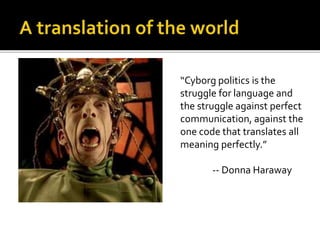Storyofme
- 1. Multimodal scholarship walk-in books & the digital humanities Helen J Burgess polyrhetor@gmail.com
- 2. “Cyborg politics is the struggle for language and the struggle against perfect communication, against the one code that translates all meaning perfectly.” -- Donna Haraway
- 3. Small tent:TEI, working with manuscripts and archives, digitizing Big tent: data and text mining, visualization, electronic scholarship and editorial work Circus tent: e-lit, art installations, critical making, experiments with electronics
- 4. Editorial work Technical & advisory editor, Rhizomes: Cultural Studies in Emerging Knowledge. [ rhizomes.net ] Editor, Hyperrhiz: New Media Cultures. [ hyperrhiz.net ] Multimedia Work Red Planet: Scientific & Cultural Encounters with Mars. 2000, DVD-Rom. Biofutures: Owning Body Parts & Information. 2008, DVD-Rom. Highways of the Mind. 2014, interactive iBook.
- 5. Medium: (nonneutral) transportation mechanism for conveyance of information. Concerned with technological underpinnings of expression. Modality: mode of expression (what senses are you engaging? Touch?Vision? Aural?). Utilizing multiple media but also concerned with process & composing choices.
- 7. “… we’re entering a time when sound, light and movement are equally important parts of the creative palette. Everyday objects whose expressive elements have long been static will now glow, sing, vibrate and change position at the drop of a hat.” (NYT, Carla Diana, “Talking, Walking Objects,” Jan. 26 2013.)
- 8. Small tent - how can it be preserved? Big tent - how can it be interrogated? Circus tent - how can it be other?
- 9.  How can scholarship be “other,” using multimodal techniques?  How can a text be “other” than what it is?
- 15. (Edgar Barrier of MercuryTheater, the voice of the Polyrhetor. Who wouldn’t trust a voice that looked like that?)
- 17. Artist’s model of a “Turing machine,” Mike Davey
- 18.  “Presumably the child brain is something like a notebook as one buys it from the stationer's. Rather little mechanism, and lots of blank sheets. (Mechanism and writing are from our point of view almost synonymous.)” [Turing, A.M. (1950). Computing machinery and intelligence. Mind, 59, 433- 460.]
- 20. ÔÇ° Enhanced iBook ÔÇ° Each chapter contains four threads: ÔÇß Context ÔÇß Chronotope ÔÇß Specters ÔÇß Machines ÔÇ° Read by chapter or by individual thread
- 21. Context -- documents and film showing the world’s fair and futurama exhibits -- 3D printable model cars from the exhibit Specters -- model of the Polyrhetor, sound recordings -- chair and speaker to simulate the oral experience Chronotope -- maps and diorama models of the spaces of the fair -- Google API maps of the interstate system over time Machine -- electronic workbench for assembling different interactive devices
- 24. “Significantly, what artists say and write about their own work remains an area of considerable controversy, especially among practicing artists: the modernist proposition of art speaking for itself lingers as a deeply-held, shared assumption for many, even those working within a postmodern aesthetic.” --W.F. Garrett-Petts and Rachel Nash
- 26. Search online for information about yourself and your demographic; create a meaningful biography from that information. Skills: 1) Content analysis 2) Narrative & metaphor 3) Distal (far) and proximal (near) sources
- 30. The assignment: create a biography of a famous person using no words. Key concept: “dimensionality” (EdwardTufte). Skill: layering and separation of information into different dimensions in the project. Genre of writing: ekphrasis.
- 36. A four-part assignment sequence in which a Shakespearean sonnet is reinterpreted in various forms according to the prompt: 1) Visual imagery 2) Sonnet structure & scansion 3) Encoding and decoding with a key 4) A “kit” for assembling a version of the sonnet with a program, recipe or other kind of instructional document.
- 37. Not from the stars do I my judgment pluck, And yet methinks I have astronomy; But not to tell of good or evil luck, Of plagues, of dearths, or seasons' quality; Nor can I fortune to brief minutes tell, Pointing to each his thunder, rain, and wind, Or say with princes if it shall go well By oft predict that I in heaven find. But from thine eyes my knowledge I derive, And, constant stars, in them I read such art As truth and beauty shall together thrive If from thyself to store thou wouldst convert: Or else of thee this I prognosticate, Thy end is truth's and beauty's doom and date.
- 46.  Installation project on cryptography and secret writing: “The Numbers Stations.”  Hyperrhiz 13: Special Issue: “Objects.”  Teaching: implementing “kits for culture” in the classroom.
Editor's Notes
- #6: While “multimedia” is used more frequently in public/industry contexts, “multimodal” is preferred in the field of composition and rhetoric. This preference for terms can be best explained by understanding the differences in how texts are valued and evaluated in these contexts. “Multimodal” is a term valued by instructors because of its emphasis on design and process, whereas “multimedia” is valued in the public sphere because of its emphasis on the production of a deliverable text. (Claire Lauer)



![Editorial work
Technical & advisory editor, Rhizomes: Cultural Studies in Emerging
Knowledge. [ rhizomes.net ]
Editor, Hyperrhiz: New Media Cultures. [ hyperrhiz.net ]
Multimedia Work
Red Planet: Scientific & Cultural Encounters with Mars. 2000, DVD-Rom.
Biofutures: Owning Body Parts & Information. 2008, DVD-Rom.
Highways of the Mind. 2014, interactive iBook.](https://image.slidesharecdn.com/storyofme-160302211149/85/Storyofme-4-320.jpg)













![ “Presumably the child brain is something like
a notebook as one buys it from the
stationer's. Rather little mechanism, and lots
of blank sheets. (Mechanism and writing are
from our point of view almost synonymous.)”
[Turing, A.M. (1950). Computing
machinery and intelligence. Mind, 59, 433-
460.]](https://image.slidesharecdn.com/storyofme-160302211149/85/Storyofme-18-320.jpg)




























